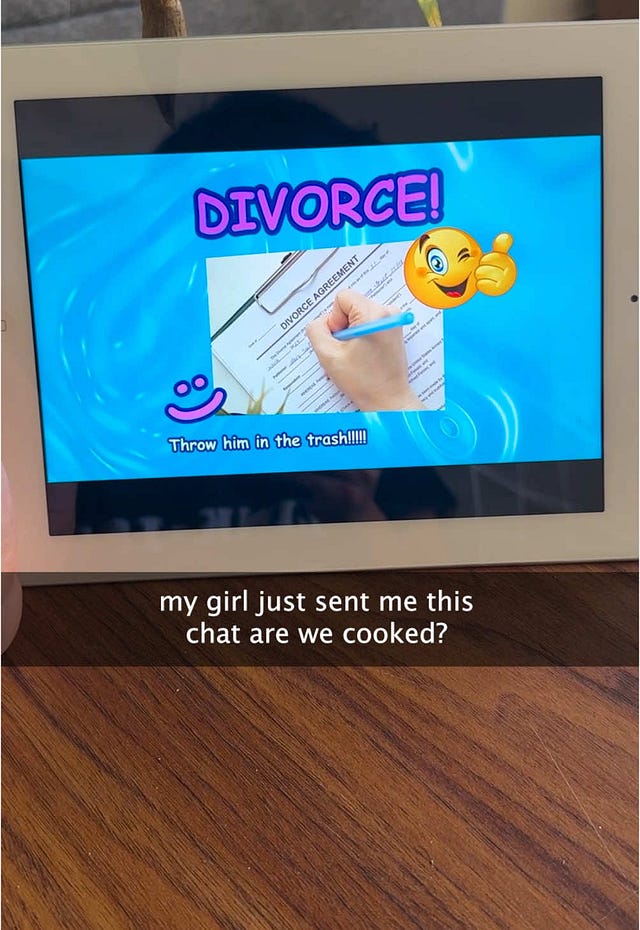6 Questions about the Events of the Past Week that Took Over the Internet
...And 3 is actually sometimes bigger than 4
Hello Gobbledeers,
How’s it going? Did you learn anything this week? I did. I learned that despite our differences, nothing brings people together like a public flogging. Red states, blue states, purple states, MAGA, Squad-lovers, Red Sox fans, Yankee fans, Goose fans, Dead fans, people on both sides of the Israeli situation, everyone. We always think we can’t bring people together, but apparently there are still things that everyone can get aligned on.
Speaking of…
This week’s episode of the Everything Is Marketing podcast is titled, “You should be thinking about crisis communications even if your boss isn't going to a concert.” In it, I spoke with PR guru Melissa Golden, an EVP at communications firm Weber Shandwick, about how companies should approach crisis communications. I don’t think SaaS companies generally think much about crisis communications strategy, and Melissa convinced me they should be thinking about it wayyyyyyy before there’s a crisis - in part because you’re prepared and in part because communications firms jack up the price when you’re desperate. You can listen to the episode here, but it’s even better if you subscribe on Apple Podcasts or Spotify.
Today we’ve got:
Insane Tiktoks can be good awareness builders
Hamburger math
This Week in Insane Branded TikToks
Last year we wrote about Nutter Butter’s completely bonkers TikTok presence, which featured an incredibly involved story (a murder? a creepy peanut butter man?) that was so deeply complex and intertwined that it required an explainer to make sense of it all.

Obviously I loved it, and the campaign got them a ton of exposure (both PR exposure and views on the platform). Any time a company is willing to step away from complaining about how hard marketing is and to try something new, I’m on board.
At the time I wrote that there are two keys to making a campaign like this work:
Believe in your strategy
Commit to the story.
This type of wacky, out-there campaign is tough in tech because many of us don’t have agreement about the strategy, and because of that we are unwilling to commit to the story. (Other than that, we’re good!)
That’s sad, because “believe and commit” leads to some fun marketing, and - while I could be wrong here - I think many of us got into marketing because it seemed like fun. Or at least more fun than being a lawyer (no offense…none taken).
I was thinking about Nutter Butter when I read about Clorox’s equally bonkers social media approach for their brands, and I wanted to make sure you saw what the teams there are doing for Pine Sol and Brita.
So, Pine Sol - a non-sexy brand without a youthful following that does not have influencers touting “Hey guys, I’m low key nervous and excited because this is the first time I’m smelling the new Pine Sol” - wanted to attract younger buyers. To do that they really embraced the TikTok vibe and - well, I could describe the Pine Sol wedding and the frog officiating it, but you should just watch it:
I originally just started linking to all the crazy-ass TikToks they have, but you can just watch them yourself here. If you want to see what believing in a strategy and committing to the bit looks like, this is as good an example as I’ve seen.
They’ve made this work with the other brands in the Clorox portfolio by thinking about what they call “cohorts” - groups of people that are similar in some non-demographic way. Rather than targeting by demographics, each brand focuses on a dozen or so cohorts at a time, swapping out new ones if others don’t click.
They gave an example from their Brita brand that was designed to resonate with the cohort of “married couples who share domestic chores.” Here’s that one with a fun little ditty featuring the lyrics, “If yo man doesn’t refill yo Brita, it’s time for a divorce:” (it’s catchy!)
 Tiktok failed to load.
Tiktok failed to load.Enable 3rd party cookies or use another browser
You’ll get the point.
In an age of AI-created content and incredible optimization functionality, there are two ways you could conceivably stand out from competitors:
Create an almost unthinkable amount of content and then focus on optimizing it to make sure the right message, right person etc. This sounds awesome and is a promise of the Internet that I’ve heard for 25 years, and because the way you’ll do that is by doing basically exactly the same thing as the 14 (140?) other companies in your space, you will all be using Clay and “hyper-personalizing” (natch), except you’re all “hyper-personalizing” and that feels like an arms race that is very challenging to win, because do you really believe that you can “hyper-personalize” better than anyone else? And that the people you’re targeting aren’t also getting targeted by your competitors so maybe you’re “hyper-personalizing” your ass off, but so is everyone else and I’m spiraling just thinking about that and how you could possibly win. And also how many times can an SDR send me a note saying, “Hey, I saw that you also went to the University of Michigan” and I’m pretty sure your competitors’ SDRs also saw that I went there, so that ain’t gonna work.
ORTake a bonkers approach to creative so people remember you in a seemingly endless sea of sameness.
Now, I just presented that as two opposing options, but that’s not quite correct. I actually think the best option is some combination of Number 2 - bonkers creative that gets people to remember you - and Number 1, which will then actually give you a way to resonate in the “hyper-personalizing” arms race.
And I really, really, really, really (really - I really really ) didn’t want to talk about this one particularly popular topic this week, but it sorta kinda ties in with this, and, well, here we are, so…
Here are 6 questions I have about the recent software executive-related event that has captivated the Internet:
One week ago, could you name a DataOps company?
Could you today?
If you could name one today, would that company be Astronomy?
Is the adage, “all publicity is good publicity” true?
If you had raised $200 million, might you think to yourself, “I would literally fire my CEO and pay him (him, obvi) $2 million severance if I could - overnight - be the best known company in my space?”
And if so, would you unleash your team of SDRs to use song names associated with the publicity in the subject lines of all the emails you’d be sending since, now, you will - literally - get a 100% open rate if your SDR’s subject line said, “Now the old king is dead, long live the king…” with musical notes around it?
Well, shit, you might.
And of course, that’s an extreme example. If suddenly your company becomes known, your prospects will open your emails. Yeah sure, maybe this isn’t how you’d go about it. But that’s my point - and this seems so obvious and stupid that I’m embarrassed to be typing it, but the fact is that people still ask if “brand marketing” is worth it - in a crowded market, the more prospects are aware of you, the more likely they are to open your email and have some amount of interest in what you want to tell them.
And, yes, one way to do that is to make TikToks where you have a frog officiating a wedding where the entire wedding party is different scents of Pine Sol. Which, ha ha, except I promise the next time I’m in Target and I walk by wherever the hell they keep the Pine Sol, those Tiktoks will be the first thing I think about.
“Americans Are Just Terrible at Math”
I often write about the tactic of using numbers as a shorthand in your marketing. Not too often. Exactly the right amount. That’s how often.
One of the challenges of using numbers in your marketing is that it assumes that your prospects have even the vaguest notion of mathematics. Not a deep knowledge of math, but just like the barest minimum. Maybe you need to know that 1,000 is larger than 100, for example.
But on the other hand, if you DO plan on using numbers, perhaps you should make sure that your prospects are not so clueless (no fault of their own, obviously!) that they do not understand basic math concepts.
To wit:
Somehow I’d never heard the story of A&W’s 1/3rd-pound burger, but here goes:
In the 1980s if you wanted a larger (“larger”) fast food burger, the leading purveyor of that option was McDonald’s with their Quarter Pounder (though not if you wanted the “largest” burger, which I assume was the Big Mac or Whopper, and I am absolutely not going to look up which of those is larger ok fine it’s the Big Mac). The Quarter Pounder, as the name suggests, contains 1/4 of a pound of meat. Excellent naming, McDonald’s.
To compete with that product, the fast food chain (and root beer purveyor) A&W came up with the brilliant idea to make a somewhat larger version of that product and sell it for around the same price. Their version contained 1/3rd of a pound of meat and they called it the “Third-Pound Burger.” Which, again, excellent naming.
In a story that sounds 1000% made up, the company claims that the burger failed because of, uh, math. After a big campaign to launch the hamburger yielded no results, the company ran focus groups and, according to the CEO at the time, someone in the focus group asked, “Why should we pay the same amount for a third of a pound of meat as we do for a quarter-pound of meat?”
Which is to say, they didn’t know that 1/3rd was larger than 1/4.
Now, that story seems quite pat, and a little too on-the-nose, but A&W actually has it on their website. Which now makes me think it’s even more a little pat and on the nose, now that I think of it.
This tale had floated around for quite some time, and I will give credit to A&W for embracing it. Three years ago they launched a campaign for a new hamburger that was quite clever:
The script mentions the story above - that in the 1980s they launched a hamburger that was larger than the competition - and asks, “How come nobody bought it?”
“Turns out Americans are really just terrible at math. Like, really bad. Everybody thought that 1/3 was smaller than 1/4 because, you know 4 is bigger than 3…Introducing the A&W 3/9ths Burger…”
That’s funny.
Always take ownership of the narrative. If you’ve lost control of the narrative of your company, acknowledge the situation, and take it back. If your competitors are spreading FUD about you, own what they say are your shortcomings. There are no products that are too expensive - maybe the prospect just isn’t ready to invest what’s necessary to make their business successful. Your burger isn’t too small, your customers are just too dumb to recognize it. Own the narrative. (And just to take this full circle - that’s what I spoke with Melissa Golden about on the Everything Is Marketing podcast episode I mentioned at the top.)
Thanks for reading to the end - it’s the best part.
Assume here is where I mention the usual ways we can work together on messaging. I’m at jared@sagelett.com.
PS - I’ve been thinking a lot this week about a book I read a few years back by the journalist Jon Ronson called So You’ve Been Publicly Shamed. He speaks with a bunch of people who have found themselves in situations where they did something publicly that, how do I put this, did not represent their best selves, and then faced an Internet-driven shaming that is actually kinda hard to read about. Ronson’s a great writer and podcast host (Things Fell Apart is particularly good), and given the events of the last week, I thought it provided a unique perspective on situations like these.




There is a marketing technique that does what you suggest by getting the CEO fired for an indiscretion to generate PR. It's called Kushnering.